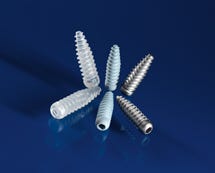PLA composite screws replace titanium in surgical implants
Fraunhofer Institute researchers have developed an injection molded biocompatible and biodegradable screw to replace titanium versions used in a variety of surgical operations. The moldable composite is made from polylactic acid and hydroxylapatite, a ceramic that is the main constituent of the bone mineral and promotes the growth of bone into the implant.
March 1, 2010
Fraunhofer Institute researchers have developed an injection molded biocompatible and biodegradable screw to replace titanium versions used in a variety of surgical operations. The moldable composite is made from polylactic acid and hydroxylapatite, a ceramic that is the main constituent of the bone mineral and promotes the growth of bone into the implant.
Titanium screws used in surgical procedures to repair torn ligaments often have to be removed after a period of time or replaced by new ones. Biodegradable PLA screws already see some use in the medical field, but broader adoption is hampered by the fact that when they degrade they can leave holes in the bone.
|
Surgeons use interferential screws to fasten cruciate ligaments in the knee. From the left screws made of polylactic acid, hydroxylapatite, and medical stainless steel. |
Philipp Imgrund, head of the biomaterial technology department at the Fraunhofer Institute for Manufacturing Engineering & Applied Materials Research (IFAM) in Bremen, said in a release that depending on the composition, the composite screws can biodegrade in 24 months.
The IFAM team says the biomaterials come in a granulate form that can be converted using conventional injection molding methods for net-shape parts that eliminate the need for any post-processing such as milling. The composite's properties approach those of real bone, with compressive strength of more than 130 newtons per square millimeter. Real bone ranges from 130-180. The researchers are working to develop other bioimplants using the process. —[email protected]
About the Author(s)
You May Also Like



